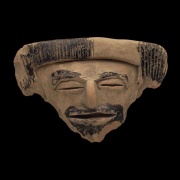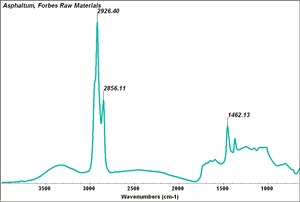Difference between revisions of "Asphaltum"
(username removed) |
|||
| (5 intermediate revisions by 5 users not shown) | |||
| Line 1: | Line 1: | ||
| − | [[File:1993.775-SC31053.jpg|thumb|]] | + | [[File:1993.775-SC31053.jpg|thumb|Mexican effigy<br>1993.775]] |
== Description == | == Description == | ||
| − | 1) An old name for [ | + | 1) An old name for [[asphalt|asphalt]] generally used prior to the 1800s. |
| − | 2) In the 17th and 18th centuries, the term asphaltum also referred to a transparent brown, [ | + | 2) In the 17th and 18th centuries, the term asphaltum also referred to a transparent brown, [[asphalt|asphalt]]-based pigment used in [[watercolor%20paint|watercolor]] and [[oil%20paint|oil paints] for glazes and shadows. The oily material can slow the drying of [[linseed%20oil|linseed oil]] producing a soft film. With time, asphaltum in dried oil films can result in the movement or disfigurement of the film as well as [[alligator%20crack|alligator cracks]]. Asphaltum was sold commercially as a transparent brown artist pigment under the name bitumen (Gettens and Stout 1966). |
== Synonyms and Related Terms == | == Synonyms and Related Terms == | ||
| Line 10: | Line 10: | ||
2) bitumen; Antwerp brown; asphalt paint; Asphalt (Deut.); asfalto (Port.); asphalte (Fr.); asfalto (Esp.); asfaltos (Gr.); alfalto (It.); bitume (It.); asfalt (Ned.); asfalto (Port.) | 2) bitumen; Antwerp brown; asphalt paint; Asphalt (Deut.); asfalto (Port.); asphalte (Fr.); asfalto (Esp.); asfaltos (Gr.); alfalto (It.); bitume (It.); asfalt (Ned.); asfalto (Port.) | ||
| − | [[[SliderGallery rightalign| | + | [[[SliderGallery rightalign|Asphaltum, Forbes Raw Materials.TIF~FTIR]]] |
| − | == | + | == Risks == |
| + | |||
| + | Combustible. Softens at slightly elevated temperatures. | ||
| + | |||
| + | Ages poorly in dried oil films resulting in movement, disfigurement and/or cracks. | ||
| + | == Physical and Chemical Properties == | ||
Soluble in petroleum hydrocarbons, turpentine, and most organic solvents. Partially soluble in oils. | Soluble in petroleum hydrocarbons, turpentine, and most organic solvents. Partially soluble in oils. | ||
| − | + | Microscopic ID: amorphous, brown particles with conchoidal fracture and/or curved particle boundaries. RI < 1.662. Isotropic in crossed polars. | |
| − | + | == Additional Images == | |
| + | |||
| + | <gallery> | ||
| + | |||
| + | File:Asphaltum PPL 200x.jpg|Asphaltum, PPL, 200x | ||
| + | File:Asphaltum XPL 200x.jpg|Asphaltum, XPL, 200x | ||
| − | + | </gallery> | |
| − | |||
| − | + | == Resources and Citations == | |
| − | + | * R.White "Brown and Black Organic Glazes, Pigments and Paints" ''National Gallery Technical Bulletin'', 10:58-71, 1986. ° R. J. Gettens, G.L. Stout, Painting Materials, A Short Encyclopaedia, Dover Publications, New York, 1966 | |
* R. J. Gettens, G.L. Stout, ''Painting Materials, A Short Encyclopaedia'', Dover Publications, New York, 1966 | * R. J. Gettens, G.L. Stout, ''Painting Materials, A Short Encyclopaedia'', Dover Publications, New York, 1966 | ||
| Line 42: | Line 51: | ||
* Art and Architecture Thesaurus Online, http://www.getty.edu/research/tools/vocabulary/aat/, J. Paul Getty Trust, Los Angeles, 2000 | * Art and Architecture Thesaurus Online, http://www.getty.edu/research/tools/vocabulary/aat/, J. Paul Getty Trust, Los Angeles, 2000 | ||
| − | + | * Eastaugh, N. et al. ''The Pigment Compendium, a Dictionary and Optical Microscopy of Historical Pigments'', Butterworth-Heinemann, 2008. | |
[[Category:Materials database]] | [[Category:Materials database]] | ||
Latest revision as of 12:57, 14 August 2020
Description
1) An old name for Asphalt generally used prior to the 1800s.
2) In the 17th and 18th centuries, the term asphaltum also referred to a transparent brown, Asphalt-based pigment used in watercolor and [[oil paint|oil paints] for glazes and shadows. The oily material can slow the drying of Linseed oil producing a soft film. With time, asphaltum in dried oil films can result in the movement or disfigurement of the film as well as alligator cracks. Asphaltum was sold commercially as a transparent brown artist pigment under the name bitumen (Gettens and Stout 1966).
Synonyms and Related Terms
2) bitumen; Antwerp brown; asphalt paint; Asphalt (Deut.); asfalto (Port.); asphalte (Fr.); asfalto (Esp.); asfaltos (Gr.); alfalto (It.); bitume (It.); asfalt (Ned.); asfalto (Port.)
Risks
Combustible. Softens at slightly elevated temperatures.
Ages poorly in dried oil films resulting in movement, disfigurement and/or cracks.
Physical and Chemical Properties
Soluble in petroleum hydrocarbons, turpentine, and most organic solvents. Partially soluble in oils.
Microscopic ID: amorphous, brown particles with conchoidal fracture and/or curved particle boundaries. RI < 1.662. Isotropic in crossed polars.
Additional Images
Resources and Citations
- R.White "Brown and Black Organic Glazes, Pigments and Paints" National Gallery Technical Bulletin, 10:58-71, 1986. ° R. J. Gettens, G.L. Stout, Painting Materials, A Short Encyclopaedia, Dover Publications, New York, 1966
- R. J. Gettens, G.L. Stout, Painting Materials, A Short Encyclopaedia, Dover Publications, New York, 1966
- Ralph Mayer, A Dictionary of Art Terms and Techniques, Harper and Row Publishers, New York, 1969 (also 1945 printing)
- Susan E. Schur, Conservation Terminology: A review of Past & Current Nomenclature of Materials, Technology and Conservation, Spring (p.34-39); Summer (p.35-38); Fall (p.25-36), 1985
- R.D. Harley, Artists' Pigments c. 1600-1835, Butterworth Scientific, London, 1982
- Dictionary of Building Preservation, Ward Bucher, ed., John Wiley & Sons, Inc., New York City, 1996
- Thomas B. Brill, Light Its Interaction with Art and Antiquities, Plenum Press, New York City, 1980
- Art and Architecture Thesaurus Online, http://www.getty.edu/research/tools/vocabulary/aat/, J. Paul Getty Trust, Los Angeles, 2000
- Eastaugh, N. et al. The Pigment Compendium, a Dictionary and Optical Microscopy of Historical Pigments, Butterworth-Heinemann, 2008.



